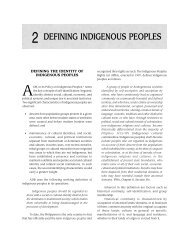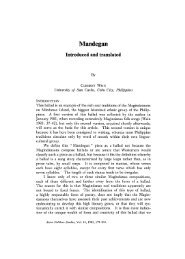Indigenous Music - Philippine Culture
Indigenous Music - Philippine Culture
Indigenous Music - Philippine Culture
Create successful ePaper yourself
Turn your PDF publications into a flip-book with our unique Google optimized e-Paper software.
There is also the popular nose flute, which produces soft and soothing sounds heard clearly in<br />
quiet late afternoons. The northern tribes call this kalleleng (Bondotc and Kankanai), tongali (Ifugao and<br />
Kalinga) and baliing (Isneg). In the Central <strong>Philippine</strong>s, it is known as lantuy among the Cuyunin, babarek<br />
among the Tagbanua and plawta among the Mangyan.<br />
In addition, some aerophones are composed of several bamboo tubes of different lengths, like<br />
the Kalinga saggeypo and the diwdiw-as, a panpipe common to Igorots. The diwdiw-as is made of five or<br />
more slender bamboo tubes tied together. The upper ends of the tubes are open and into these a performer<br />
blows without his lips touching the instrument. On the other hand, the six saggeypo tubes are left untied and<br />
may be played by a group of people. The simultaneous blowing of the pipes results in harp-like sounds.<br />
The Maguindanao, meanwhile, have the suling or ring flute, so called because the blowing<br />
end is encircled with a rattan ring to create mouthpiece. The Tausog have a six hole single-reed sahunay,<br />
with its characteristic cone-shaped pandan-leaf bell.<br />
Chordophones also bound in many parts of<br />
the Archipelago. These include the bamboo zithers, the<br />
Spanish guitars, the bamboo violins and the lutes.<br />
The zither is a stringed instrument made from<br />
a single bamboo section, around three to four inches in<br />
diameter, with a node at each end. Serving as strings,<br />
however, are raised narrow strips of the outer skin fibers of<br />
the bamboo itself, with the ends still attached to the body of<br />
the instrument. Small wedges are placed beneath the strings<br />
to produce different tensions – and thus varying pitches – as<br />
the player plucks the strings.<br />
Variations of the zither can be found all over<br />
the country, like the Ilongot kolesing or the Ibaloi kalshang, the Negrito pas-ing and Ifugao patting; in the<br />
central <strong>Philippine</strong>s, the Tagbanua play the pa’gang, while the Mangyan have the kudlung. The southern<br />
zither is called tawgaw (Bagobo).<br />
Two-stringed lutes knows as the kudyapi among the Bukidnon, hegalong among the T’boli or<br />
the kadlong or kudlong in Central Mindanao are characterized by a boat shape or an elongated oval<br />
between 40 to 45 inches long, and have tightening rods made of wood and frets of beeswax and two-wire<br />
strings tuned in unison – one serving ad drone, the<br />
other providing the melody.<br />
These long “guitars” or boat lutes are<br />
carved in soft wood usually to represent a mythical<br />
two-headed animal, the naga (serpent) or crocodile,<br />
or perhaps the modified head, body and tail of the<br />
sarimanok, a cockerel-like bird. The kudyapi is alos<br />
known as a “speaking instrument” because it figures<br />
prominently in courtship. It is also used as an<br />
accompaniment for dances.<br />
Examples of chordophones using bows<br />
are the three-stringed gitgit of the Tagbanua, the<br />
spike fiddle called duwagey of the Bilaan and the<br />
biola of the Tausog, which is similar to the European<br />
violin used to accompany songs.<br />
Perhaps the greatest number of indigenous musical instruments belong to the idiophone<br />
group. In particular, some of these idiophones are the jew’s harp, suspended beams, bamboo buzzer,<br />
percussion sticks and gongs.<br />
The jew’s harp is a very thin slit of bamboo or brass with a narrow vibrating tongue in the middle longitudinal<br />
section. Placed between the lips of the player, its tongue is made to vibrate by striking the projecting end of<br />
the instrument with the thumb or by pulling a string attached to it. The mouth of the player acts as the<br />
resonator, and as the shape of the mouth cavity changes, the pitch and quality of the sound varies. This<br />
enables the player to communicate message with his instrument. For this reason, the jew’s harp is a favorite<br />
of lovers and is played by both men and women. It is thus considered a “speaking intrument”.

















